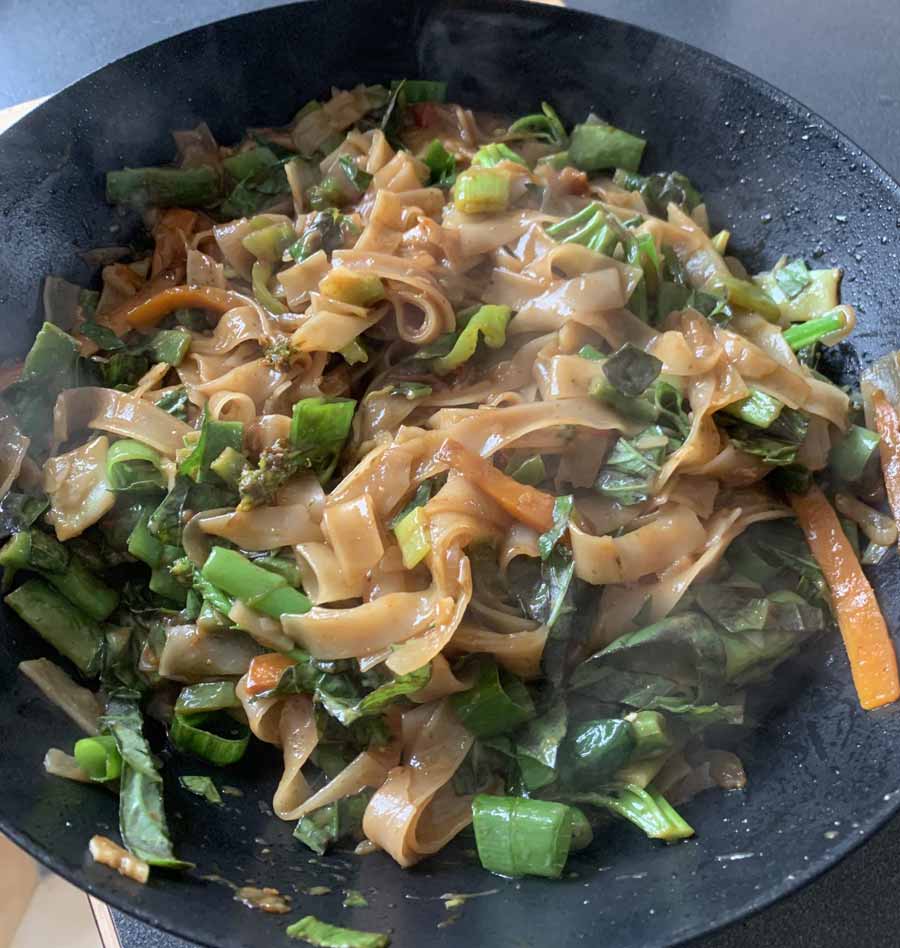author
Jacques Lawinski
post
- 30/01/2023
- No Comments
- Food
share
A delicious Thai-inspired dish that has been made vegan by making your own oyster sauce and fish sauce, and using tofu as your protein! The fresh basil takes it to another level, a great crowd-pleaser!

Ingredients
Serves 4
Vegan oyster sauce:
10 dried shiitake mushrooms, soaked in 2 cups water
1 tbsp finely chopped ginger
1 tbsp oil
1/2 cup coconut aminos
8 pitted dates
Vegan fish sauce:
1 cup water
3 tbsp dulse (seaweed pieces)
2 tsp salt
1/4 cup dried shiitake mushrooms
1 tsp miso
1 tbsp tamari (or soy sauce)
Pad kee mao sauce:
4 tbsp vegan oyster sauce
1/3 cup soy sauce
2 tsp vegan fish sauce
2 tsp brown sugar
2 tbsp water
1 tsp chilli sauce/fresh chilli
Noodles:
200g wide rice noodles
2 tbsp oil
2 shallots, or one onion
1 carrot, thinly sliced
200g firm tofu
4 cloves of garlic, chopped
1 courgette, sliced
1 small capsicum, sliced
2 spring onions, thinly sliced
1 tomato, chopped
1 cup of Thai basil, or regular basil, chopped
Method
For the vegan oyster sauce:
- Soak the shiitake mushrooms in warm water for around 4 hours, until soft. Take them out of the bowl, squeeze out the water, and then thinly slice them. Strain the remaining water to remove any dirt.
- In a hot pan, heat up the oil. Then add the sliced mushrooms, ginger, and a pinch of salt. Sautée for about 4 minutes.
- Add a tablespoon of the coconut aminos to the mushrooms in the pan. Take off the heat after one minute.
- Put the mushrooms and ginger, the soaking water, the dates, and the rest of the coconut aminos in a blender and mix for a minute or so until you end up with a smooth liquid. Set aside to use later.
For the vegan fish sauce:
- In a saucepan, add the water, dried mushrooms, salt, and the dulse. Heat until boiling and leave to cook for 15 minutes on a low heat.
- Remove from the heat, and let it cool slightly. Pour the mixture through a sieve, and squeeze out the juice from the mushrooms and the seaweed.
- To the bowl with the liquid, add in the miso paste and the tamari. Mix these in to the sauce. Set aside to use later.
The noodles
- Prepare all the vegetables by slicing everything up and putting them in piles on your chopping board to use. The secret to this is being able to cook everything quickly in a hot wok or frying pan.
- Mix the ingredients for the sauce in a separate bowl and set aside.
- Heat up a pot of boiling water for the noodles, and when you are ready to cook the vegetables, put the noodles in the boiling water.
- In a wok, add one tablespoon of oil and heat until hot. Add the shallots/onions and the carrots, and cook for two minutes. Then add some more oil, and add the tofu. Cook until the tofu is golden brown.
- Add the vegetables and the garlic and cook for another two minutes.
- Strain the noodles when they are cooked, and add them to the frying pan on top of the noodles. Pour the sauce on top, and then mix the sauce into the vegetables and noodles. Stir until well mixed through.
- Take off the heat, and add the chopped basil, then serve!
Our food section provides ideas and inspiration for great, fresh food. Our recipes will always be open and free for everyone to use, without any advertising.
All our articles are freely accessible because we believe that everyone needs to be able to access to a source of coherent and easy to understand information on the ecological crisis. By eating well, and in ways that have a better impact on the environment, we can begin to change the way the whole society produces food.
If you've learned something today, or feel inspired, please consider donating, to help us produce more great recipes and share this knowledge with a wider audience.
Why plurality.eco?
Our environment is more than a resource to be exploited. Human beings are not the ‘masters of nature,’ and cannot think they are managers of everything around them. Plurality is about finding a wealth of ideas to help us cope with the ecological crisis which we have to confront now, and in the coming decades. We all need to understand what is at stake, and create new ways of being in the world, new dreams for ourselves, that recognise this uncertain future.

